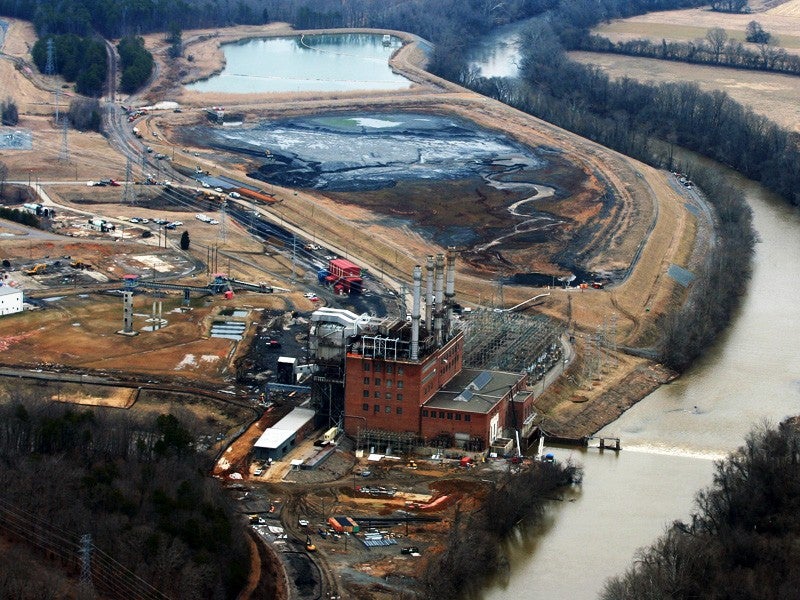As Coal Ash Problems Continue, DEQ In Position To Order Effective Cleanup
Report on Virginia’s toxic coal ash problem
Contacts
Andrea Delgado, Earthjustice, (202) 797-5240
,
Emily Russell, Virginia Conservation Network, (804) 424-1285
,
Greta Bagwell, Virginia League of Conservation Voters Education Fund, (804) 225-1902
,
Michael Bochynski, Clean Water Action, (202) 895-0420, ext. 106
The Virginia Department of Environmental Quality is facing increasing pressure from the public to clean up coal ash in a manner that is protective of both human health and the environment. According to a new report released by Virginia Conservation Network in partnership with the Virginia League of Conservation Voters, Clean Water Action, and Earthjustice, every major region of Virginia contains coal ash ponds that are leaking and unstable.
Coal ash is the waste left over when coal is burned for electricity. The cheapest way to dispose of coal ash is in unlined pits on the banks of creeks and rivers. When these pits leak or breach, exposure to toxics in coal ash can cause cancer, neurological, cardiovascular and reproductive damage in humans and can poison fish and wildlife.
Through existing state regulations and new standards under EPA’s coal ash rule, DEQ has the power to order utilities to remove coal ash to safe, lined landfills away from Virginia’s waterways. This preferred alternative would run contrary to Dominion Power’s recently announced plans to close its coal ash ponds by capping the waste in place, leaving pollutants to continue leaking into nearby rivers and streams.
Virginia Senator Donald McEachin's district is home to the East End Landfill, which has faced penalties from DEQ for improper storage of coal ash. Senator McEachin said, "Virginia communities stand to benefit from dry, lined storage of coal ash. Ash storage away from waterways eliminates the threat of toxic pollution to our health and environment. It also creates an economic opportunity for Virginia's waste management industry to responsibly store this ash in state-of-the-art landfills."
Duke Energy, the utility responsible for the coal ash spill into the Dan River, recently announced that it would be removing coal ash from leaking pits in North Carolina and storing it in lined landfills. All utilities in South Carolina have similarly committed to removing coal ash from lagoons and storing it in dry, lined storage away from rivers.
“Dominion’s own reports to DEQ have shown measurable amounts of pollution from its coal ash ponds across the state. Excavation of existing coal ash ponds and removal of the toxic waste to lined landfills away from our drinking water is the only option for the Commonwealth,” says Emily Russell of Virginia Conservation Network, “Virginia should not settle for anything less than what our neighbors in the Carolinas are getting when it comes to closing coal ash ponds.”
“As we know all too well after the Dan River spill, coal ash ponds are a ticking time bomb and DEQ’s current oversight is woefully lacking in preventing another possible environmental calamity,” said Greta Bagwell, deputy director of Virginia LCV. “While Dominion’s voluntary measures to close their coal ash reservoirs are worthwhile, stronger oversight is needed in the long-term to ensure this process is completed in a way that doesn’t further threaten our health or natural resources.”
In addition to the Dan River spill, the report identifies nearly a dozen other sites of coal ash contamination across the Commonwealth. One example is Ash Pond E at Dominion’s Possum Point Plant in Dumfries, which contains 48,400 tons of coal ash just 200 feet from a nearby creek. The pond has a 72-inch corrugated metal pipe running beneath it, just like the pond at the Dan River Plant that suffered a catastrophic breach when a corroded pipe collapsed.
Facing the increasing problems of coal ash pollution, the U.S. Environmental Protection Agency finalized disposal regulations for coal ash in December 2014. The rule requires immediate inspections, enhanced design standards for all new ponds and landfills, prohibitions on dangerous dumping in and near drinking water sources, strict federal cleanup levels and more. Now, states must adopt EPA’s standards as a minimum.
"The improper storage of toxic coal ash next to Virginia's scenic rivers and waterways, along with major deficiencies in the Department of Environmental Quality's regulatory program have caused harm and threatened the safety of our communities. This report clearly demonstrates the need for better oversight of coal ash disposal in Virginia," said Michael Bochynski of Clean Water Action.
On Capitol Hill, the House of Representatives will soon be voting on H.R. 1734, a bill designed to undermine the new EPA rule. Virginia Congressman Gerald Connolly, whose district is home to the Possum Point coal ash ponds, has spoken out repeatedly in opposition to the bill.

Additional Resources
About Earthjustice
Earthjustice is the premier nonprofit environmental law organization. We wield the power of law and the strength of partnership to protect people's health, to preserve magnificent places and wildlife, to advance clean energy, and to combat climate change. We are here because the earth needs a good lawyer.